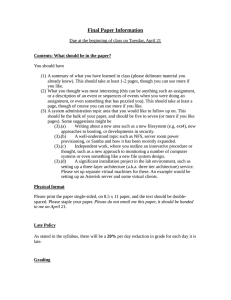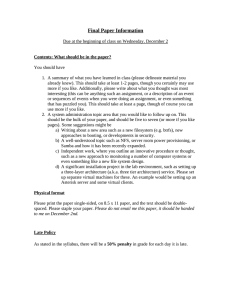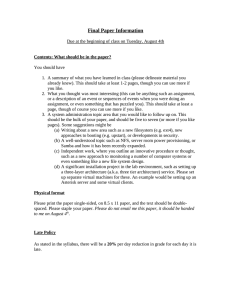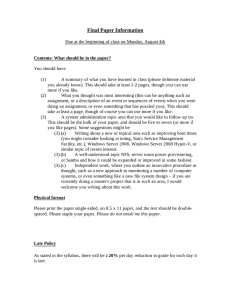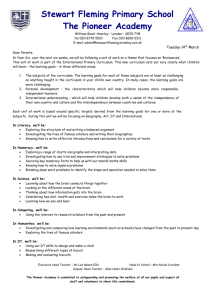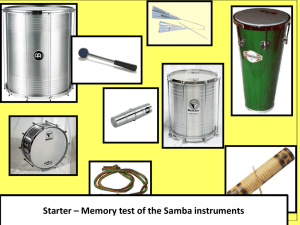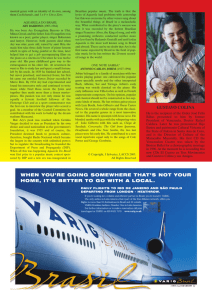Samba: Brazil’s Defining Personality
advertisement
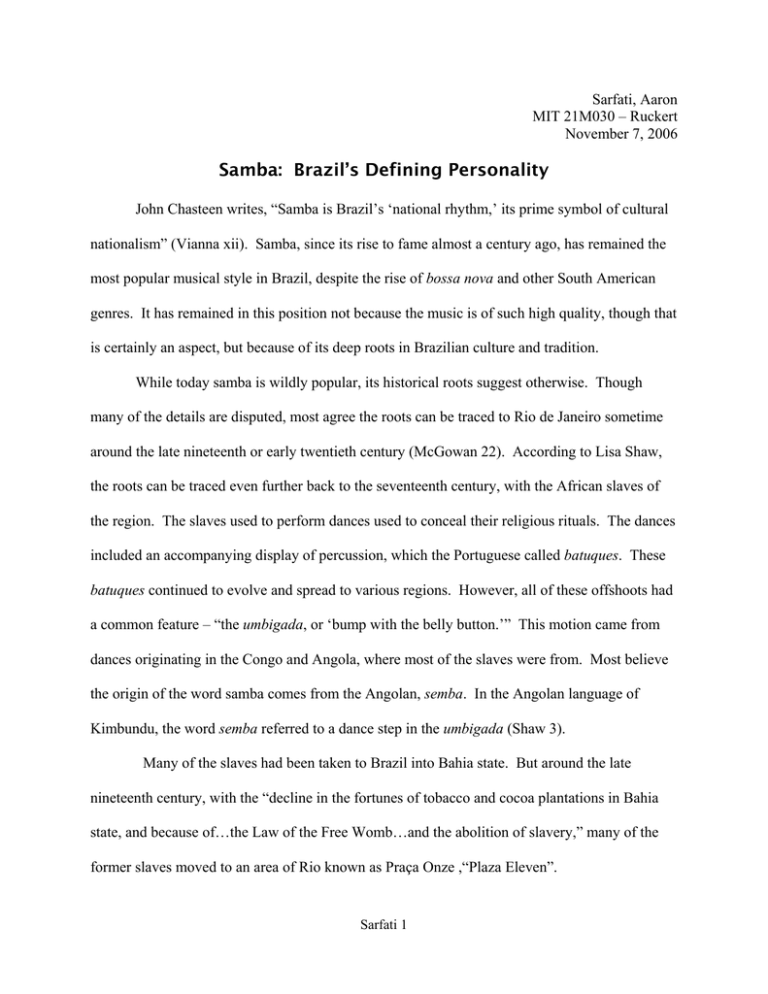
Sarfati, Aaron MIT 21M030 – Ruckert November 7, 2006 Samba: Brazil’s Defining Personality John Chasteen writes, “Samba is Brazil’s ‘national rhythm,’ its prime symbol of cultural nationalism” (Vianna xii). Samba, since its rise to fame almost a century ago, has remained the most popular musical style in Brazil, despite the rise of bossa nova and other South American genres. It has remained in this position not because the music is of such high quality, though that is certainly an aspect, but because of its deep roots in Brazilian culture and tradition. While today samba is wildly popular, its historical roots suggest otherwise. Though many of the details are disputed, most agree the roots can be traced to Rio de Janeiro sometime around the late nineteenth or early twentieth century (McGowan 22). According to Lisa Shaw, the roots can be traced even further back to the seventeenth century, with the African slaves of the region. The slaves used to perform dances used to conceal their religious rituals. The dances included an accompanying display of percussion, which the Portuguese called batuques. These batuques continued to evolve and spread to various regions. However, all of these offshoots had a common feature – “the umbigada, or ‘bump with the belly button.’” This motion came from dances originating in the Congo and Angola, where most of the slaves were from. Most believe the origin of the word samba comes from the Angolan, semba. In the Angolan language of Kimbundu, the word semba referred to a dance step in the umbigada (Shaw 3). Many of the slaves had been taken to Brazil into Bahia state. But around the late nineteenth century, with the “decline in the fortunes of tobacco and cocoa plantations in Bahia state, and because of…the Law of the Free Womb…and the abolition of slavery,” many of the former slaves moved to an area of Rio known as Praça Onze ,“Plaza Eleven”. Sarfati 1 In Praça Onze, many older Bahian matriarchs (known as tias) hosted gatherings in their homes for music, dance, and worship. One such tia, Tia Ciata, is credited with helping form the new musical style known as samba. It was in her house that the formal founders of samba, Pixinguinha, Donga, João da Baiana, Heitor dos Prazeres, and Sinhô, all gathered and played “lundus, marchas, choros, maxixes, and batuques in jam sessions that must have been incredible to watch.” It was also in Tia Ciata’s house where the first samba, “Pelo Telefone,” was created in 1916. It was these men who “popularized samba, started developing its structure, and set it on its course toward becoming one of the world’s greatest musical genres” (McGown 23-25). During the 1920s, samba made a gradual split into two different classifications, categorized namely by those who created it. On one side was the samba of the central area by the sambistas. It was given the label of ‘Afro-Brazilian culture.’ On the other side was the samba of the morros (samba-de-morro), the poor musicians who had been forced out of Rio due to expensive cost of living and the increasing white, European presence. The morros lived in the shantytowns surrounding Rio, and were subject to increasing police persecution (Shaw 5). However, the isolation of the morros led to the creation of the first “Samba School,” Deixa Falar (loosely, “Let them speak”) in 1928. It was in this group, created by Ismael Silva and others that the samba style began to take on a more formal, organized structure (McGowen 25). One of the other founders, Bide, introduced a way of coordinating the tempo for large groups of musicians and dancers. He advocated the playing of “the second beat of a 2/4 measure strongly on the surdo bass drum and using the tamborim in the samba percussion section” (Murphy 9). The Samba School also clearly differentiated samba from similar genres such as maxixe and marcha. They introduced longer notes and two-bar phrasing, and made the tempo slower. This standardization became the standard reference for samba (McGowen 25). Sarfati 2 As samba developed, its lyrics increasingly focused on one of just a few topics – women and love affairs, and the malandro (Shaw 7). John Murphy describes the malandro as “the slick urban hipster who lives by his wits at the expense of others, a lifestyle and behavior called malandragem” (12). The malandro was so prevalent in the music of the 1920s, an entire class of samba, samba malandro, was named after it. The story of the malandro had so much power, it came to represent the way of life for many of the poor people. Many of them spurned worked in favor of a gambling and sex-filled lifestyle. Such was the power, that it was part of the reason for the authorities to ban performances of samba, in an attempt to suppress mob-type gatherings. With the new Vargas government in 1930, the authorities took a different approach to quell the violence: tolerance. The government attempted to “Brazilianize” samba by making the AfroBrazilian practices permitted with certain rules and restrictions. As a result, “samba became increasingly acceptable in the eyes of the while elite” (Shaw 9-11). In the late 1930s, the more upscale neighborhoods began to produce a new type of samba known as samba-canção, “songlike samba”. This samba “emphasized the melody more than the rhythm, added more complex harmonies, and had more sophisticated lyrics.” It became highly popular among the middle-class, as it was a softer, cooler type of samba. It also became the basis for the offshoot later to develop in the 1950s called bossa nova (McGowen 28). The samba of the morros formed the basis for the popular annual festival in Brazil known as Carnaval. “Carnaval…is a pre-Lenten celebration…that culminates in the three days preceding Ash Wednesday” (Murphy 19). Carnaval began before the period of samba, developing from end-of-the-year celebrations that dated back to the colonial era. In the early twentieth century, “groups from the middle and lower classes began parading together in costume,” and the music was slowly replaced by the marcha and ultimately samba. Those from Sarfati 3 the morros faced police repression when they tried to join in the celebrations, but when Vargas took over, “the samba schools were given official recognition” (19-20). As Carnaval grew in popularity as a tourist attraction, so did the samba schools. In the 1960s, the many samba schools began competing against each other for lucrative prizes. Soon thereafter, samba schools were being bought by businesspeople and the activities were becoming more commercialized. In fact, there grew out a specific samba for the Carnaval, known as samba-de-enredo, which was a more “percussion-based samba which provides the accompaniment for the [Carnaval] processions” (Shaw 194). The samba features a variety of instruments used to produce a very party-like atmosphere, especially in the samba-de-enredo, used for the Carnaval celebrations. Each samba school consists of a number of the following instruments: 1) surdos – the bass drums that provide the foundation beat for the rest of the percussion section (bateria), 2) caixas – the snare drums, 3) tamborins – cymbal-less tambourines that are hit with sticks, 4) cuica – friction drum, 5) reco­ reco – scraper, 6) agogô – double bell, 7) cavaquinho – a ukulele-like instrument that adds harmonies, and 8) the puxador – the lead singer (McGowen 21). The most important of the instruments are the surdos. There are three types of surdos, used for different purposes. The largest surdo is the one that plays the second beat in the 2/4 samba. It holds the rhythm and keeps the whole bateria together. The middle surdo plays less forcefully than the large surdo and plays on the first beat. The smallest surdo plays “on the beats and off-beats, ‘cutting’ the rhythm and adding syncopation” (43). In recent times, a new style of samba has emerged – pagode. It began taking off in the mid-1970s during parties, called pagodes, where people would gather to play samba. The main distinction is the change in instrumentation. The founders of pagode added a four-string banjo, Sarfati 4 replaced the heavy surdos with the tan-tan, which sat on the player’s lap, and dispensed of the drumsticks with the new hand-played repique-de-mão drum. In the early 1990s, a more commercial form of pagode emerged, with lyrics that were more romantic and more instruments to include the keyboard, drum set, and brass. Pagode was also distinguished by a slower tempo, richer harmonies, and the use of the partido-alto rhythm, which “features a vocal duet, patterns of syncopated sixteenth notes that are tied across the beat, and the use of the harmonic cycle ii7­ V7-I-VI7” (Murphy 24-5). Samba has had a long and distinguished history. From the early pre-abolition days, to the modern pagode and bossa nova styles, samba has undergone many challenges and changes. After being standardized in the first of many samba schools, which were established in seclusion from the local authorities, samba started to take on the Brazilian culture. With a regime-change came a revolution in how people viewed samba music and it was brought it into the public eye. Eventually, samba replaced the previous genres as the main Carnaval music. From there, samba quickly grew into a large commercial music scene, and differentiated into many different styles, including the now internationally popular bossa nova, with the likes of Sergio Mendes. In Brazil, aside from soccer, you will not find anything more popular than samba music. As Chris McGowan puts it, “all you have to do is go to downtown Rio on Friday during ‘happy hour’ after work. The bars and sidewalks…are full…of various professionals celebrating the oncoming weekend…And the party music is always samba” (53). Sarfati 5 Bibliography Behague, Gerard. ‘Samba’, Grove Music Online ed. L. Macy (Accessed 23 October 2006), <http://www.grovemusic.com> McGowan, Chris and Pessanha, Ricardo. 1998. The Brazilian Sound: Samba, Bossa Nova, and the Popular Music of Brazil, New Edition, Philadelphia: Temple University Press. Murphy, John P. 2006. Music in Brazil, 1st Edition, New York: Oxford University Press, Inc. Shaw, Lisa. 1999. The Social History of the Brazilian Samba, 2nd Edition, Burlington: Ashgate Publishing Company. Vianna, Hermano (edited by John Chasteen). 1999. The Mystery of Samba: Popular Music and National Identity in Brazil, 1st Edition, Chapel Hill: North Carolina Press. Sarfati 6
